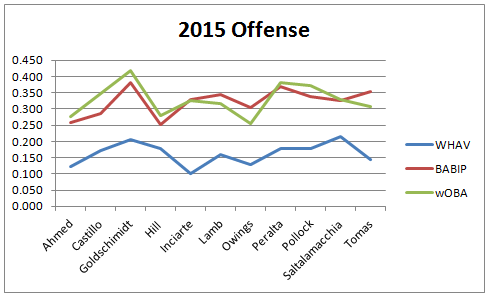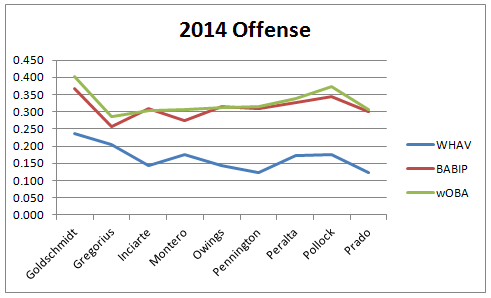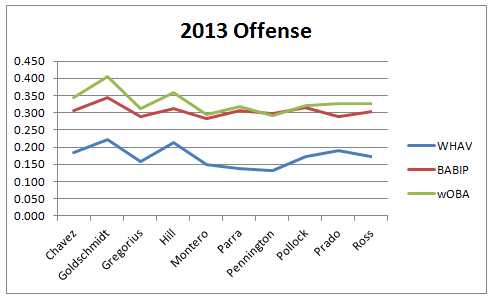Double Plus: Hitting Offense Hard
There are a lot of theories about what drives offense in baseball. We know that on-base percentage is good, but not every team builds it’s team to maximize OBP. Some teams are low-OBP in nature but hit for boatloads of power. Other teams are low-power but also low-strike out. Both approaches can work – just ask the Astros (big power, big strikeouts) and Royals (low-power, low strikeouts) who happened to be pretty good baseball teams this year. Even though we have OBP as the old standby in terms of how to build an offense, there are examples of success to the contrary.
For what it’s worth, the Diamondbacks were 15th in power (ISO) and 14th in strikeout rate (K%) in 2015. The offense was good, but it’s not like it was big time power or a minuscule strikeout rate that got the job done. So I’m still stuck wondering just what drove them beyond on-base percentage.
A big trend here at Inside the ‘Zona over the last two seasons has been hard-hit balls. So, I figured we should take a look at how hard hit balls have related to offensive production. Presumably, hitting the ball hard helps, in general. Have a look at the 2015 offense’s key pieces:
I chose to highlight three categories to see how much correlation there was: well-hit average (WHAV) from ESPN’s TruMedia, batting average on balls in play (BABIP) and weighted on-base average (wOBA). These tell us three things: how often the ball was hit hard from each batter, how often all batted balls became hits and how well the player performed offensively as a whole. My theory was that the more often a batter hit the ball hard, the more often his batted balls would fall in for hits, and the more often batted balls became hits, the better the player would perform overall. While higher BABIPs aren’t always sustainable, they are helpful for producing offense while they do exist.
By and large, hitting the ball hard frequently did help BABIP for the D-backs. Areas where they diverged from the norm can be seen with Ender Inciarte and Jarrod Saltalamacchia for opposite reasons. Inciarte didn’t hit the ball hard but legged out a lot of hits. Meanwhile, Salty hit it hard, but it was fielded, he wasn’t about to run it out. Aaron Hill was also an outlier, but I’m going to attribute that to declining skills more than anything.
But did BABIP, largely aided by WHAV, lead to better overall offense (wOBA)? The two moved together relatively consistently. For guys with big power, their wOBA’s eclipsed their BABIP by a decent margin (thank you, home runs) while those with less pop often found their wOBA and BABIP closer together. Those with strikeout issues often found their wOBA below their BABIP. To see if this was just a blip, here are the same graphs for 2013 and 2014:
Wow, despite a couple small deviations, these same trends held true in the two yeas prior. We may be on to something here, which is to say that we are further confirming the notion that hard hit balls drive offense (unless you have severe contact problems). Some plate discipline is necessary, of course, and a good approach can help make sure a power hitter gets good balls to hit. With less power, things like speed and contact rate come into play as wOBA and BABIP come closer together.
None of this is meant to serve as a “conclusive study.” It is, by definition, not one. This is just an observation. It’s one of those things that you’re sitting around thinking about and decide to investigate. This is why we started Double Plus to begin with. And who knows, maybe we’ll circle back to this idea, use a larger sample and add a few more categories. Still, I feel like the idea that hitting the ball hard is good for offense continues to make sense. While the names on the back’s of the 2016 D-backs hitters won’t change much from what this year’s crop looked like, we’ll keep working with the numbers to see how they can sustain or improve their performance. Even if the pitching improves next year, it’ll be the offense that makes the team a contender.
4 Responses to Double Plus: Hitting Offense Hard
Leave a Reply Cancel reply
Recent Posts
@ryanpmorrison
 Best part of Peralta’s 108 mph fliner over the fence, IMHO: that he got that much leverage despite scooping it out… https://t.co/ivBrl76adF, Apr 08
Best part of Peralta’s 108 mph fliner over the fence, IMHO: that he got that much leverage despite scooping it out… https://t.co/ivBrl76adF, Apr 08 RT @OutfieldGrass24: If you're bored of watching Patrick Corbin get dudes out, you can check out my latest for @TheAthleticAZ. https://t.co/k1DymgY7zO, Apr 04
RT @OutfieldGrass24: If you're bored of watching Patrick Corbin get dudes out, you can check out my latest for @TheAthleticAZ. https://t.co/k1DymgY7zO, Apr 04 Of course, they may have overtaken the league lead for outs on the bases just now, also...
But in 2017, Arizona ha… https://t.co/38MBrr2D4b, Apr 04
Of course, they may have overtaken the league lead for outs on the bases just now, also...
But in 2017, Arizona ha… https://t.co/38MBrr2D4b, Apr 04 Prior to the games today, there had only been 5 steals of 3rd this season (and no CS) in the National League. The… https://t.co/gVVL84vPQ5, Apr 04
Prior to the games today, there had only been 5 steals of 3rd this season (and no CS) in the National League. The… https://t.co/gVVL84vPQ5, Apr 04 RT @OutfieldGrass24: Patrick Corbin has a WPA of .318 and it's only the fifth inning., Apr 04
RT @OutfieldGrass24: Patrick Corbin has a WPA of .318 and it's only the fifth inning., Apr 04
Powered by: Web Designers@outfieldgrass24
 Old friend alert https://t.co/xwSHU0F8Hn, 2 hours ago
Old friend alert https://t.co/xwSHU0F8Hn, 2 hours ago Every once in a while you get a beer that's just a little off... Usually happens to me at airports., 8 hours ago
Every once in a while you get a beer that's just a little off... Usually happens to me at airports., 8 hours ago If Pollock doesn’t sign with a team that wears red uniforms I’m going to be really disappointed. Working theory: Se… https://t.co/zHn9DqzEiD, 10 hours ago
If Pollock doesn’t sign with a team that wears red uniforms I’m going to be really disappointed. Working theory: Se… https://t.co/zHn9DqzEiD, 10 hours ago The work here by @Britt_Ghiroli is splendid https://t.co/c8tSq0vw3T, 10 hours ago
The work here by @Britt_Ghiroli is splendid https://t.co/c8tSq0vw3T, 10 hours ago RT @TheAthleticAZ: Plenty of #Dbacks fans gave it some time - and they still don't like the idea. The "why" from @ZHBuchanan
https://t.co/9oDlvue3fV, 18 hours ago
RT @TheAthleticAZ: Plenty of #Dbacks fans gave it some time - and they still don't like the idea. The "why" from @ZHBuchanan
https://t.co/9oDlvue3fV, 18 hours ago
Powered by: Web Designers








You should have added base running as a reason why the D-Backs offense was so good.
The D-Backs had one of their best years ever running the bases. The D-Backs had decent speed at almost every position, which led to 132 stolen bases (2nd in the NL) and a 75% stolen base percentage (5th in the NL). The D-Backs also did an outstanding job of getting the extra 90 feet whenever the opportunity presented itself and they made very few base running blunders.
So basically, the D-Backs got every run they were supposed to get thanks to good base running.
Dave, the speed component was covered in the Chip Hale Report Card piece to a degree and, as the title suggested here, this was about hard-hit balls boosting offense. I completely agree that base running and speed help; I alluded to that in the 4th and 7th paragraphs. The idea with these Friday posts, however, is to try to keep it short.
Your ideas, however, are well-founded and certainly a big part of the offensive success. Hitting the ball hard isn’t everything – just ask Yasmany Tomas. I’m looking forward to adding a few other inputs as the offseason continues, and base running will certainly be one of them.
I hadn’t read that one yet 🙂
Tomas and Inciarte proved that you don’t have to hit the ball hard to get on base. Both did a fair amount of slapping the ball the other way. This is becoming a lost art in baseball these days, and one of the reasons so many teams implement defensive shifts.
I remember a team trying a shift against Inciarte “once” this year. He simply hit the ball the other way for a base hit and said “Thank you very much” 🙂
Actually, it was 2nd and 5th in MLB, not just the NL…